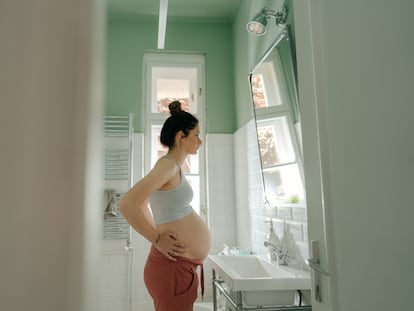Preeclampsia during pregnancy is a warning of cardiovascular risk
Recent studies link the appearance of this disorder in pregnant women with subsequent heart disease, even years after having given birth


Preeclampsia is characterized by the appearance of hypertension after the 20th week of pregnancy, accompanied by a clinical sign like proteinuria (protein in the urine), edema or analytical abnormalities. It can affect the health of the future mother, as well as the proper development and growth of the fetus. “It is estimated that between 2% and 12% of women suffer from preeclampsia during their pregnancy, and the number seems to be increasing slightly, which could be related to the increasingly advanced age in pregnant women,” explained Salomé Álvarez, president of the Federation of Associations of Midwives of Spain (FAME). The expert added that this is a pathology of complex etiology that begins with a flow disturbance at the placental level, before evolving into a systemic affectation with an impact mainly on the cardiovascular, renal, hepatic and neurological levels.
Although the risk of suffering from this disease is usually associated only with pregnancy, “the background of this disease was formally recognized by the American Heart Association a decade ago as an independent risk factor for cardiovascular disease and stroke,” said Álvarez. Dr. Antonia Sambola Ayala, coordinator of the Working Group for Women in Cardiology of the Spanish Society of Cardiology, explained that what was not known before is that this risk to women’s cardiovascular health “could remain there for such a long time after the birth.”
Now, several recent studies point precisely in this direction. The first, published last January in the European Journal of Preventive Cardiology and titled Risk and trajectory of premature ischemic cardiovascular disease in women with a history of preeclampsia, is based on records of more than a million pregnant Danish women between 1978 and 2017. According to the results, those who suffered from preeclampsia during their pregnancy were four times more likely to have a heart attack and three times more likely to have a stroke during the 10 years after childbirth. Although lower, the risk of heart attack or stroke was still double among women with preeclampsia more than 20 years after giving birth.
“It is not yet clear whether preeclampsia increases the risk of stroke by itself or if it is a marker of a risk profile. Following this last hypothesis, some even suggest that preeclampsia is the first cardiovascular event,” explained Sara Hallum, lead author of the study and researcher at the Section of Epidemiology of the Department of Public Health at the University of Copenhagen, in Denmark. The expert pointed out that women who suffered from preeclampsia during a pregnancy after age 35, or those who suffered this complication in more than one pregnancy, are those who presented a higher cardiovascular risk in the medium and long term.
According to Sambola, also a cardiologist at the Vall d’Hebron Hospital in Barcelona, Spain, eclampsia (a rise in blood pressure with liver and kidney damage that can lead to seizures) is linked to endothelial dysfunction, which is also common in other pregnancy complications. “Arteries are usually dynamic entities that contract and dilate depending on various factors. When there is an alteration in endothelial function, this vasodilation capacity is lost and there is more vasoconstriction, and therefore, vascular problems.”
Another observational study published last February in The British Journal of Medicine, titled Adverse pregnancy outcomes and long term risk of ischemic heart disease in mothers, concludes that the five main complications of pregnancy — preterm birth, low birth weight, preeclampsia, gestational diabetes and other blood pressure disorders — are correlated with a higher risk of ischemic heart disease. This risk is maintained over time, even many years after giving birth. Specifically, in the 10 years after delivery, the relative rates of ischemic heart disease doubled in women with other hypertensive disorders of pregnancy, and were 1.7 times higher in those with preterm birth, 1.5 times in those with preeclampsia, 1 .3 times in those with gestational diabetes and 1.1 times in those who gave birth to a small-for-gestational-age baby.
Casey Crump, a professor and researcher at the Department of Family Medicine and Community Health of the Icahn School of Medicine at Mount Sinai Hospital in New York and lead author of the study, explained to EL PAÍS that most relative risk rates decreased with time, but they remained significantly increased up to 40 years or more after delivery. “Genetic factors may, at least in part, contribute to pregnancy complications, as well as the future development of ischemic heart disease, in which case adverse pregnancy outcomes are signs of preexisting cardiovascular risk,” he pointed out. However, some evidence shows that adverse pregnancy outcomes could also trigger new changes in the blood vessels and the heart that were not present before the pregnancy, which could persist or progress afterwards, potentially leading to ischemic heart disease.
An opportunity for prevention
According to Sambola, these pregnancy complications receive no attention after the delivery. “I think that many health professionals lack knowledge about these risk factors because, even though they were known before, it is only now that more evidence is beginning to be disseminated.” The expert added that “there is a lack of information and a significant ignorance regarding cardiovascular disease in women,” she said, “both regarding prevention and when it comes to management and treatment.”
FAME’s Salomé Álvarez considers that in light of this evidence, adequate health education is necessary so women can become aware of these risks and be attentive to possible early signs of these diseases that may favor early diagnosis. “It is not enough just to report the increased risk due to the presence of these pathologies. The point is not scaring. We must give women the resources and knowledge of what is in their power to do for their health, such as keeping healthy habits to reduce risks,” she said.
In addition to being useful for identifying women with an increased risk of cardiovascular disease, Hallum believes that the results of these investigations should also make it clear that targeted interventions cannot wait until pregnant women with preeclampsia are eligible for conventional midlife risk detection programs. For this, she points out that it is necessary to increase awareness of the link between preeclampsia and the risk of cardiovascular disease among physicians, obstetricians and gynecologists. “If we want to reduce the burden of cardiovascular disease in this vulnerable group of women, we must implement preventive strategies soon after delivery,” she added.
Their study indicates that the early postpartum period represents a window of opportunity for targeted interventions. “It is true that routine follow-up could take decades and that the number of women with preeclampsia is large, but we must at least identify those who are more likely to benefit from screening. In this sense, our study suggests that they are women aged 35 years or older, or women with recurrent preeclampsia.”
Sign up for our weekly newsletter to get more English-language news coverage from EL PAÍS USA Edition
Tu suscripción se está usando en otro dispositivo
¿Quieres añadir otro usuario a tu suscripción?
Si continúas leyendo en este dispositivo, no se podrá leer en el otro.
FlechaTu suscripción se está usando en otro dispositivo y solo puedes acceder a EL PAÍS desde un dispositivo a la vez.
Si quieres compartir tu cuenta, cambia tu suscripción a la modalidad Premium, así podrás añadir otro usuario. Cada uno accederá con su propia cuenta de email, lo que os permitirá personalizar vuestra experiencia en EL PAÍS.
¿Tienes una suscripción de empresa? Accede aquí para contratar más cuentas.
En el caso de no saber quién está usando tu cuenta, te recomendamos cambiar tu contraseña aquí.
Si decides continuar compartiendo tu cuenta, este mensaje se mostrará en tu dispositivo y en el de la otra persona que está usando tu cuenta de forma indefinida, afectando a tu experiencia de lectura. Puedes consultar aquí los términos y condiciones de la suscripción digital.
More information
Últimas noticias
Most viewed
- Reinhard Genzel, Nobel laureate in physics: ‘One-minute videos will never give you the truth’
- Pablo Escobar’s hippos: A serious environmental problem, 40 years on
- Charles Dubouloz, mountaineering star, retires at 36 with a farewell tour inspired by Walter Bonatti
- Why we lost the habit of sleeping in two segments and how that changed our sense of time
- The Florida Keys tourist paradise is besieged by immigration agents: ‘We’ve never seen anything like this’










































